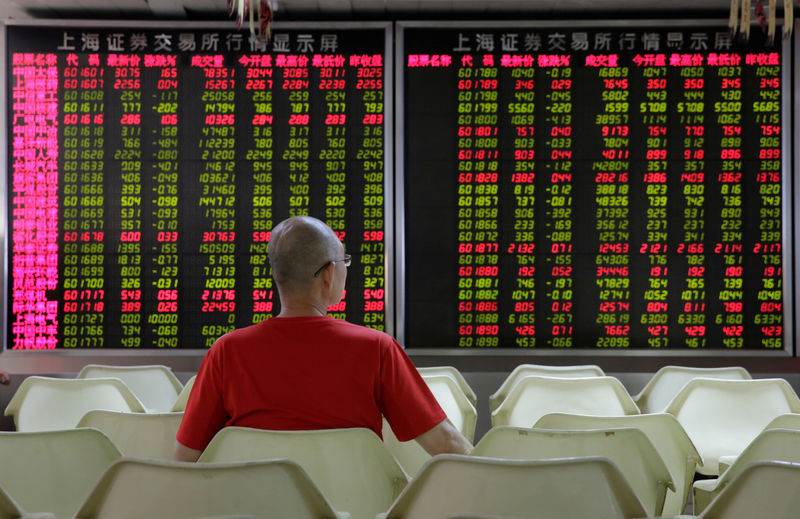 © Reuters. FILE PHOTO: British Pound Sterling banknotes are seen at the Money Service Austria company’s headquarters in Vienna
© Reuters. FILE PHOTO: British Pound Sterling banknotes are seen at the Money Service Austria company’s headquarters in ViennaBy Saikat Chatterjee and Maiya Keidan
LONDON (Reuters) – As negotiations become fraught before Britain’s exit from the European Union in March, tensions of a different kind are surfacing on the currency markets — derivatives activity is rising sharply as investors bet on a weaker sterling.
Hopes of progress on a Brexit deal between London and Brussels have fueled a sterling rebound to nine-week highs; yet the view broadly remains that talks will go down to the wire, setting British assets up for a volatile few months.
EU leaders’ rejection this week of Prime Minister Theresa May’s Brexit plan already knocked the pound on Friday, and many investors warn against banking too much on a positive outcome.
Collateral damage to the British economy could be enough to warrant holding a short sterling position even as negotiations get more intense, some investors believe.
“We are happy to hold our short pound position against the euro through currency forwards as we think there are a lot of red lines that the EU and the UK have to cross before a deal can be signed,” said Kaspar Hense, a portfolio manager at BlueBay Asset Management, which runs $60 billion in funds.
The International Monetary Fund warned this week that the Britain’s economy would shrink if it departed the EU without a Brexit deal but damage was inevitable no matter what terms it leaves on.
UBS calculates the economy would lose 6.9 percent of output in the event of a “soft” Brexit, rising to a 10 percent hit should the exit be “hard”, without a trade deal in place.
Most investors, even those without a firm conviction on the final Brexit outcome or the economic outlook, say they prefer trading sterling via derivatives rather than on the spot foreign exchange market.
That’s because outstanding short positions on the pound in the futures market are more than $5 billion. Such a large bet makes trading the spot pound very vulnerable to any positive headlines on Brexit negotiations because that could force speculators to exit short bets.
Indeed, sterling has rallied by 5 percent from more than one-year lows hit in mid-August to nearly $1.33 and not far away from a 2018 high of above $1.43 hit in April.
GRAPHIC: Short positions stacked up against pound – https://reut.rs/2MOouZC
TEXTBOOK
A hard Brexit on the other hand may push the currency 10 percent below current levels, according to Andreas Koenig, global head of FX at Amundi. That makes this a “textbook environment” for buying “volatility”.
Volatility
For example, Thomson Reuters data shows a large buildup in currency options at $1.27 and $1.34 against the pound, suggesting hedge funds are content to play the ranges but have increased their option purchases.
As demand for these options has picked up, one-month implied measures of sterling volatility — or “vol” in market parlance — has increased rapidly, making short-dated sterling options more expensive in comparison with similar-maturity options on other currencies.
Vol for six-month maturities is now at its highest level in seven months, relative to similar options in euros. This indicates that “market activity is more wide-eyed to a no-deal Brexit and more sterling protection is being sought”, according to Phil McHugh, chief markets analyst at Currencies Direct.
Rising volatility measures have also boosted the popularity of derivatives such as option straddles that offer the opportunity to profit from currency fluctuations without forcing investors to take outright long or short sterling positions.
“We bought relatively long-term volatility in cable (pound-dollar) and euro-sterling as this way we are putting a foot into the door with an option, allocating some risk and being long vol is an attractive strategy,” Amundi’s Koenig said.
GRAPHIC: Sterling’s performance since Brexit – https://reut.rs/2MNhOLa
BRINKSMANSHIP
Mark Richards, a global multi-asset strategist at JP Morgan Asset Management in London, said the path to a soft Brexit would probably involve some degree of brinkmanship by the British government and the EU before a compromise is reached.
The rapid rise in volatility has surprised some investors.
“That is a trade that we have looked at, buying cheaper volatility in pound/dollar,” said Andrea Angelone, co-founder, CEO and CIO at London-based Amagis Capital. “But the volatility has really spiked up a lot now to around 10 percent.”
The jump in implied volatility is an indicator of increased hedging activity from investors at a time when broader gauges of directional bets have declined.
Risk reversals for sterling
“From what we hear and see in hedge fund portfolios, directionality on the pound versus U.S. dollar has actually been significantly reduced,” said Philippe Ferreira, senior cross asset strategist at Lyxor Asset Management.
GRAPHIC: Bets on volatile pound climb in run up to Brexit – https://reut.rs/2MOBw9p
GRAPHIC: Markets shift towards pricing in “no deal” Brexit – https://reut.rs/2MP8XJ0
Source: Investing.com





























